



Kitchens forge memories
• Kitchens
• Bathrooms
• Space Additions
• Garages
• Deck & Screened Porches
• Basements






• Kitchens
• Bathrooms
• Space Additions
• Garages
• Deck & Screened Porches
• Basements

offers in-home care for all ages and medical staffing that goes above and beyond. We call it
BrightStar Care’s goal is to provide the right type of assistance that allows residents of all ages to remain safely and comfortably in their homes – wherever “home” is – an apartment, single family, or a senior living neighborhood. These services range from companion care all the way through skilled care. They include:

Companion-level care: Includes meal preparation, companionship, light housekeeping, errand running, and transportation to and from appointments and social engagements.
Personal care: Includes companion-level care plus medication reminders and assistance with “Activities of Daily Living,” including bathing, mobility assistance, toileting and dressing.
Skilled Care: Includes medication management, infusions, wound care, catheter care, feeding tube administration, and around-the-clock care delivered by a nurse.

In addition to Joint Commission accreditation — which demonstrates our commitment to safety and quality standards — our compassionate and proactive caregivers deliver a personalized nurse-led plan of care right in your loved one’s home.


Jenifer Alty Massie Regional Director of Operations
WHEN TO SEEK IN-HOME CARE
Recognizing when it’s time to seek in-home care is crucial for ensuring the well-being and safety of your loved ones. Here are some signs that it might be time to consider in-home care services:
• Difficulty with Daily Activities: If your loved one struggles with daily tasks such as bathing, dressing, or meal preparation, in-home care can provide the necessary assistance to help them maintain their independence.
• Frequent Falls or Injuries: An increased frequency of falls or injuries may indicate that your loved one needs more supervision and assistance to ensure their safety.
• Chronic Health Conditions: Managing chronic conditions such as diabetes, heart disease, Alzheimer’s disease, or cancer can be challenging. In-home care provides specialized support to manage these conditions effectively.
• Medication Management Issues: If your loved one is having trouble keeping track of their medications or is experiencing adverse effects from improper medication use, inhome care can help with medication management and compliance.
WHAT TO LOOK FOR WHEN SEEKING IN-HOME CARE
When searching for in-home care for your loved ones, it’s essential to consider several key factors to ensure they receive the best possible care:
Personalized Care Plans
Professional and Compassionate Staff
Comprehensive Range of Services Commitment to Quality and Safety 24/7 Availability
Local Expertise and Community Involvement
Positive Testimonials and Proven Track Record

Big Doors from Andersen allow you to enjoy spectacular spaces for relaxing, entertaining or just being.
sppaemoHgnidliuBretneCC
sppaemoHgnidliuBretneCC
1 ywH notgnihsaW rekooB 0073
1ywH notgnihsaW rekooB


)0456722-127(
4daoR cirtcelE 870
4 daoR cirtcelE 870
)0450046-009(
Mateno, VA 21214
)0456722-127(
Rekonao, VA 2 8104
)0450046-009(
s moc.sppacpoh
Mateno, VA 2 1214
4daoR cirtcelE 870
Rekonao, VA 2 8104
Rekonao, VA 2 8104
)0450046-009(
s moc.sppacpoh

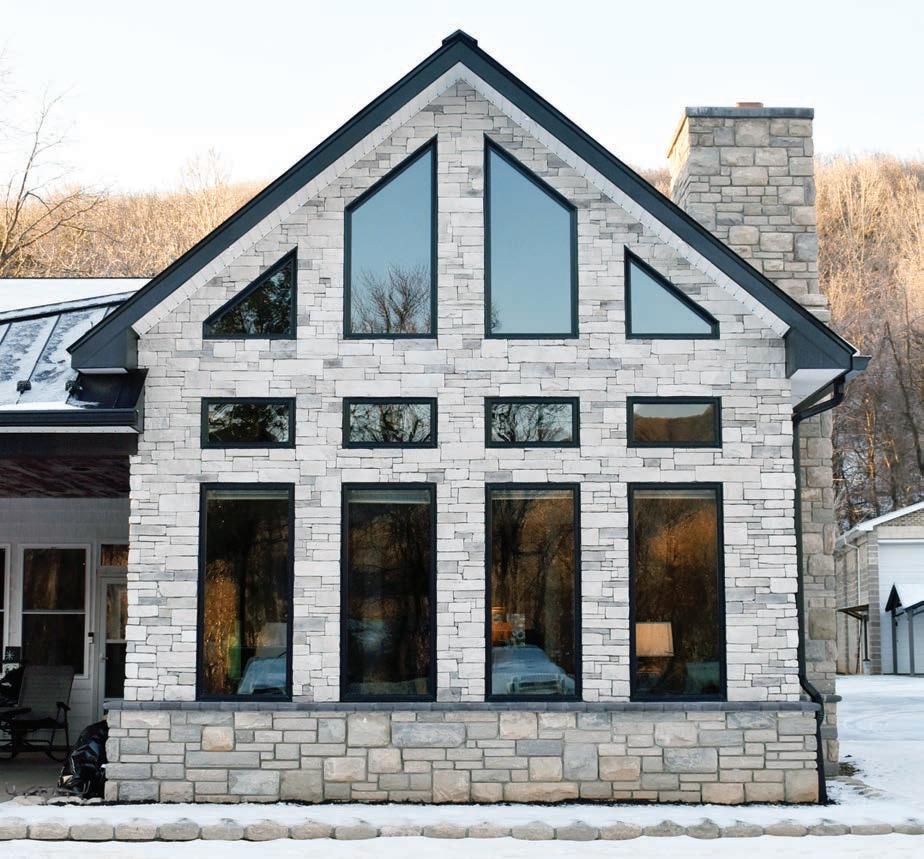
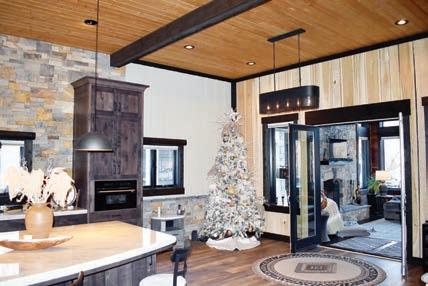
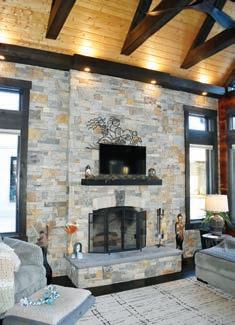










For over 20 years, our comprehensive design and execution services have evolved to meet the needs of the valley. We provide everything from patios and retaining walls to routine maintenance plans and irrigation, ensuring a seamless and stress-free outdoor experience for homeowners.
Dive into family fun with a fiberglass pool, perfect for creating a resort in your backyard. Add both functionality and style to your property with an expertly crafted hardscaping project, including patios, fire pits, and fireplaces. Illuminate your landscape with our outdoor lighting. Ensure efficient water distribution with an irrigation system, and enhance the natural beauty of your property with a professional plant installation. We strive to be your one stop shop to live the best life outside.
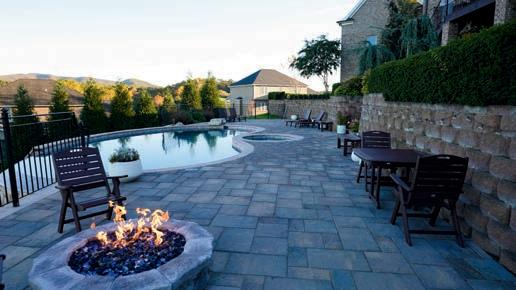















KATHERINE FULGHUM KNOPF








In the bleak midwinter
Frosty wind made moan Earth stood hard as iron
Water like a stone
Snow had fallen Snow on snow, snow on snow
In the bleak midwinter, long, long ago — “In the Bleak Midwinter” by Christina Georgina Rossetti (c. 1872)
While this hauntingly beautiful hymn carries a hopeful message, it reminds me that this time of year can be both lovely and difficult. Early February and its long, dark days can really feel like the bleak midwinter! Our aim for this issue is to weave together a cozy blanket with threads of kindness, creativity and spring dreams. We want to lift your spirits!
Let’s begin with Shelley’s eight ideas for beating the wintertime blues. She’s right: we need to get some fresh air, try something new and find joy in everyday life. That’s also the idea behind dopamine décor: the art of infusing your home with vibrant colors, playful patterns and happy details that spark joy. We share ideas for adding sparkle to your home with mirrors and using the Colors of the Year to enliven your rooms.
Still looking for more ways to brighten your days? Look no further than Becky’s “Sweets for the Sweet” recipes. Chocolate for the win! And as my kids used to say: Sharing is caring!
Laurel elucidates another way to lift our spirits: try a random act of kindness. Doing something unexpected, with no expectations in return, can boost our moods and that of others, creating a ripple of random kindness. We certainly could use more of that in the world! Check out her ideas for World Kindness Week.
If you’re still yearning for a mood boost, try making your own terrarium. These miraculous enclosed systems are selfsustaining and stunning.
Finally, look to our Showcase Home for inspiration. May you find creative ideas in the photos and storytelling to include in your own home.
Everything in this issue is meant to bring a smile to your face. If it does, pay it forward.
Happy Reading!
Donna Dunn | donna@jamesrivermedia.com

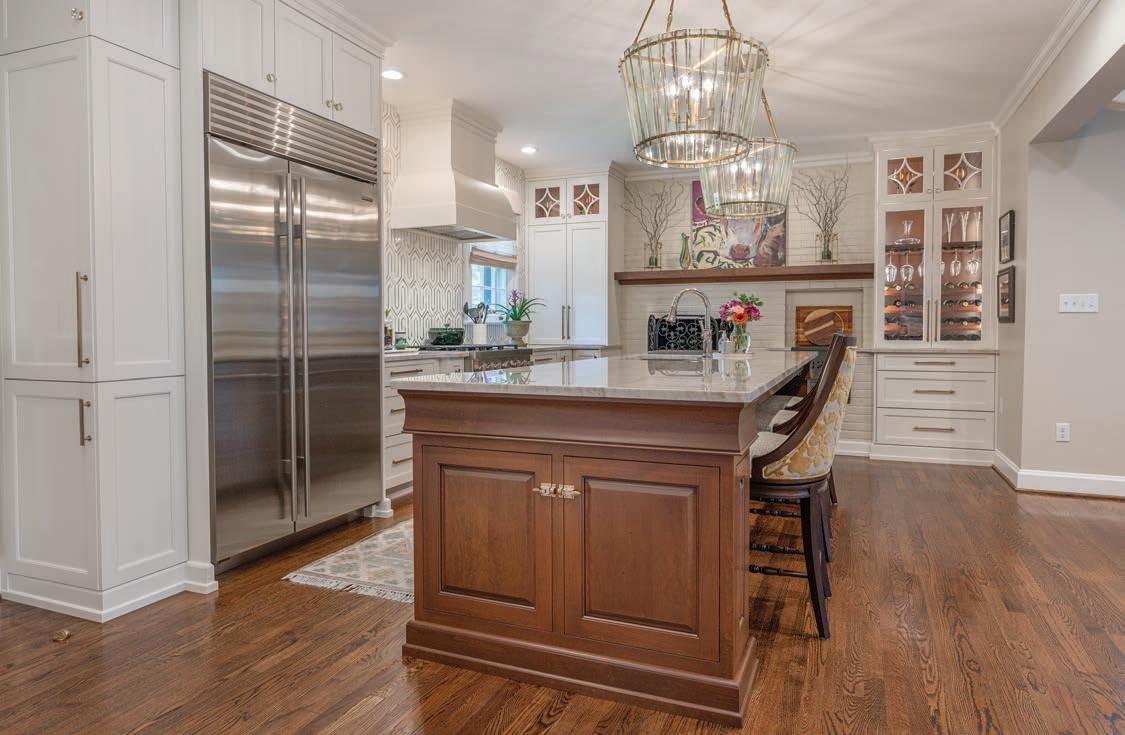

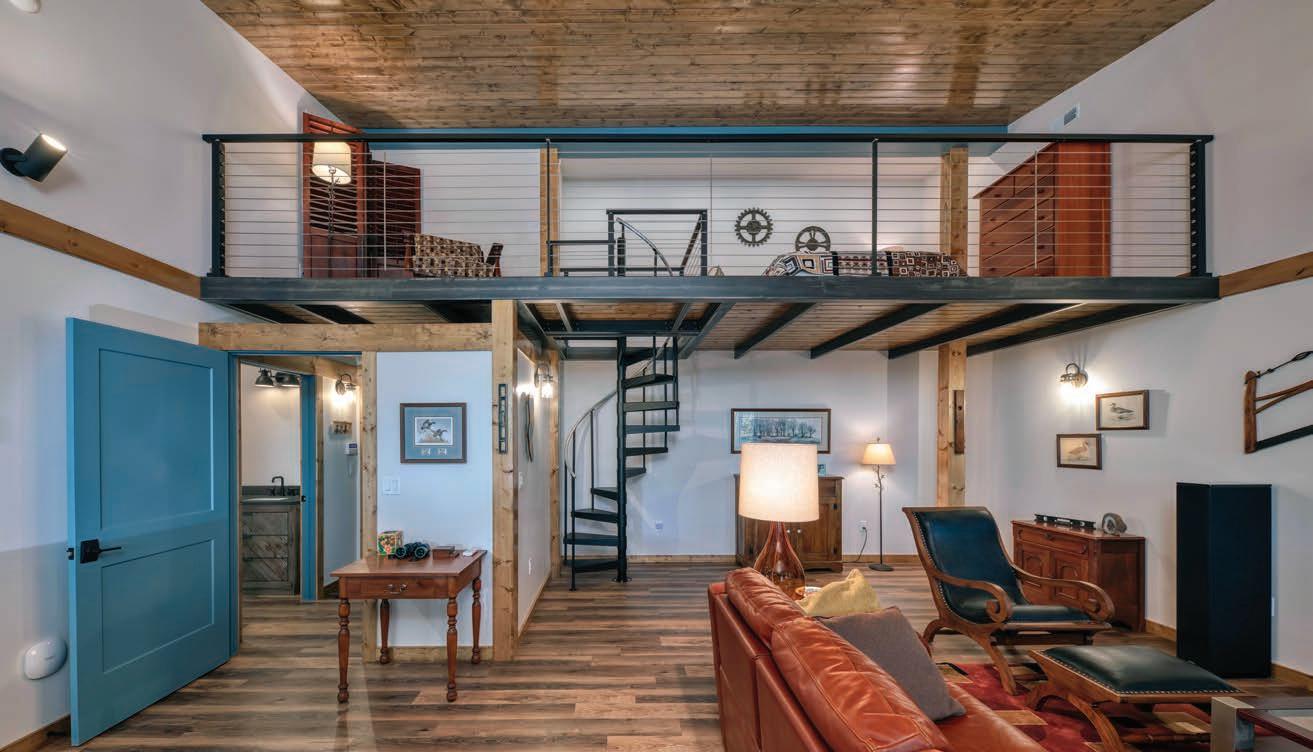








VOLUME 1 8 ISSUE 1
PUBLISHER
Trish Roth
EDITOR
Donna Dunn
ART DIRECTOR
Kira Rider
CONTRIBUTING EDITOR
Katherine Fulghum Knopf
CONTRIBUTING WRITERS
Shelley Basinger
Mitzi Bible
Becky Calvert
Martha S. Coffey
Kate Ericsson
Laurel Feinman
Jerry Hale
Katherine Fulghum Knopf
Margie Lippard
Kendall Atkins Livick
Sloane Lucas
Ginny Smith
Nicole van Esselstyn

PHOTOGRAPHER
Kathryn Feldmann
GRAPHIC DESIGNER
Donna Collins
SALES DIRECTOR
John Mazzei
ADVERTISING SALES
Kirsten Morey Becker
Lisa Bowers
Kenny Shelton
SUBSCRIPTIONS
Roanoke Valley HOME is published five times annually by James River Media, LLC. For an annual subscription, please send $20 and your name, address and telephone number to: Roanoke Valley HOME 109B Tradewynd Drive, Lynchburg, VA 24502
For advertising information please call (434) 845-5463 or email sales@jamesrivermedia.com.


To discuss coverage of an event relating to home or garden, please contact Roanoke Valley HOME at home@jamesrivermedia.com
JAMES RIVER MEDIA, LLC (434) 845-5463
Copyright 2025 by James River Media, LLC. All rights reserved. No part of this publication may be reproduced or transmitted in any form or by any means without written permission from James River Media, LLC. All pictorial material reproduced in this magazine, whether in a produced ad or by itself, has been accepted on the condition that it is with the knowledge and prior consent of the photographer or the artist concerned. As such, James River Media, LLC is not responsible for any infringement of copyright or otherwise arising out of publication thereof. The information contained herein has been obtained from sources believed to be reliable. However, James River Media, LLC makes no warrant to the accuracy or reliability of this information.


BY KENDALL ATKINS LIVICK
If there’s one word that represents the colors of 2025, it’s “grounded.” To recap, 2024 was all about the hues of blue. We began that year ready to blow with the wind and go with the flow. Yet, coming off the heels of a tumultuous, storm-tossed year, it’s no surprise that the collective culture no longer yearns to roll with the tides. We now move from sea to land, taking comfort in the earthly colors of nature.
Primer
Color trends tend to reflect what we are seeing culturally in global events, music, art, cinema, fashion and collective emotion. With so much competing for our attention in the form of social media, streaming platforms, political agendas, influencers and gurus, it’s easy to see why many are looking to unplug and “touch grass” as the saying goes. Instead of spreading our attention outward in a million different directions, we are being called to look within and seek inner wisdom in moments of calm reflection.
Luxurious reds are fittingly the top color trend for 2025 across palettes. Ranging from rich brown to deep magenta, these comforting colors exude warmth and complexity, with undertones of plum, leathery brown, velvety cinnamon and red wine. A secondary trend coming down the pike is yellow. Muted shades of yellow are expected to grow in popularity, as this color promotes positivity and effervescence. Time will tell how yellow shows up in 2025 and beyond. The pinks and peaches of yesteryear haven’t disappeared, but they have toned down. Rather than showing up as pops and bold statements, pastels are now appearing more in a soft, supportive role.
Matte and satin sheens offer a depth of texture for a layered look that invites home inhabitants and guests into a world of cozy charm. Without overpowering the senses or competing with other elements in the room, all palettes across major paint brands are nature-inspired and subdued.



Mocha Mousse has been rolled out as Pantone’s much anticipated color of the year – evoking a sense of “connection, comfort and harmony.” It’s no coincidence that this rich hue inspires associations with treats like chocolate, cacao and coffee. The light and airy, yet simultaneously grounding tone encourages onlookers to take pleasure in life’s simplicity, embrace the contentment of the moment and enjoy harmony with cherished companions. Not too much of a departure from last year’s Peach Fuzz, Mocha Mousse delves deeper into the decadence of a special dessert. This brown is predicted to show up in monochromatic schemes and in pairings with familiar peachy pastels, along with many other vibrant shades spanning the color spectrum. We can expect to see Mocha Mousse with golden accents for a sophisticated feel and alternatively with reeded and cane wood for an organic earthy vibe.
Each year, Pantone tunes into the “global zeitgeist” and chooses a color that represents the collective mood and future hope. According to this year’s themes, the desires of 2025 are pleasure, comfort and community — all things that Mocha Mousse delivers by reminding us of our beloved sweets.


75 Builders Pride Drive Hardy, VA 24101
540-719-1431
www.bydesigninteriorsofva.com




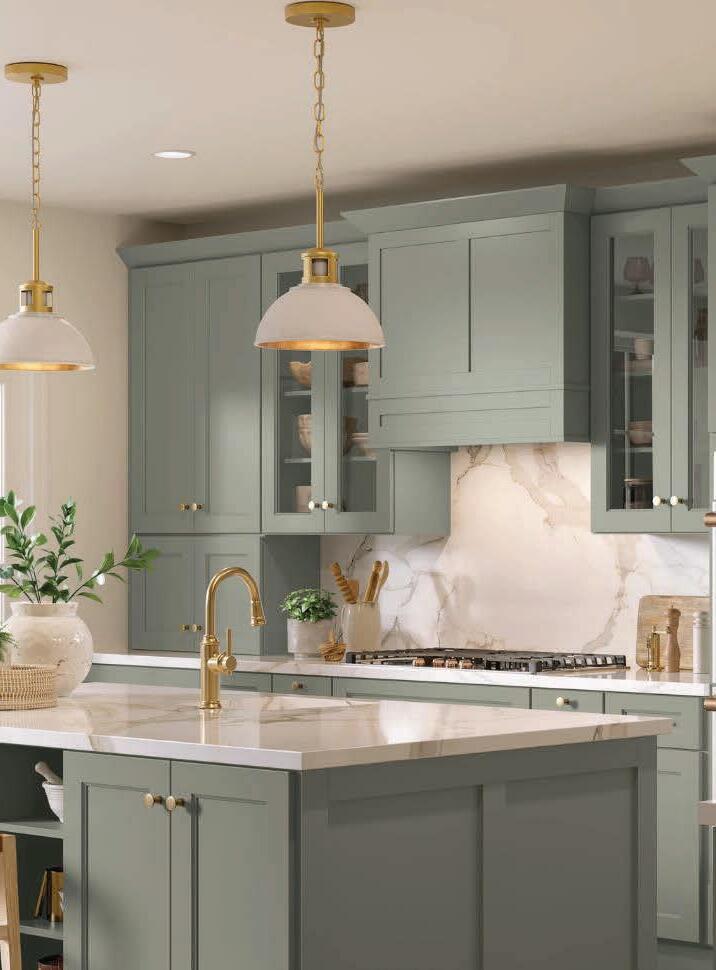
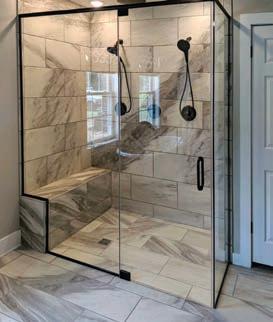




Epitomizing this year’s moody red trend, Benjamin Moore chose Cinnamon Slate as its color of the year. Encouraging us to “embrace the beauty of quietly colorful hues,” this color aims to create “smooth familiarity.” All tones in this palette have been chosen with comfort and warmth in mind. Other 2025 colors are Sea Salt, Leather Saddle Brown, Chowning’s Tan, Tissue Pink, Stained Glass, Ashwood Moss, Rosepine, Paris Rain and Glacier White. These colors can work individually or in tandem for cohesion and effortless transitions from room to room.

Continuing down the red dirt road, Behr selected Rumors, a “deep ruby red” as its color of the year. The Behr palette strives for versatility with many other shades, ranging from cool to warm. The idea is to offer enough options to “express any style and enhance any environment.” Greens, blues, reds, purples and pastels can all be found within the palette. Following suit with most of the other colors of 2025, all hues are muted. Along with Rumors, other options include Nutmeg Frost, Blank Canvas, Even Better Beige, Frosted Jade, Rock Crystal, Jackfruit, Oxford Street, Wild Truffle, Boreal, Aerial View, Colorful Leaves, Gardener’s Soil, Amazon Jungle, Black Sapphire and Cracked Pepper.


Rather than homing in on one color, Sherwin-Williams opted for a “color capsule” to celebrate 15 years of “Colors of the Year.” Color Marketing Director Sue Wadden says this year’s colors can embody any design style with a “balanced and usable assortment of shades.” The color capsule includes Grounded (a rich and muddy brown with red undertones), Sunbleached, Chartreuse, Bosc Pear, White Snow, Rain Cloud, Clove, Malabar and Mauve Finery. Sherwin-Williams picks have a grounding element intended to blend trendiness with timelessness. Many of the hues are reminiscent of the popular neutrals of past years, but – like the rest of the palettes – more subdued.


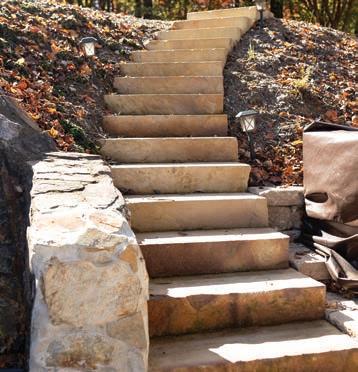



Rather than one single palette, PPG’s color picks focus on a central theme that encapsulates colors grouped to represent four different design styles. The overall vibe is “Kinetic.” PPG anticipates “extraordinary new developments” to unfold over the next decade, moving us to activate and adapt. PPG’s color of the year is Purple Basil, which straddles the line between the “calming qualities of blue and energetic warmth of red.”
The Extra Celestial palette nudges us toward “self-trust,” featuring stellar shades of purple and blue, among others emblematic of the cosmos. These include Milk Paint, Shaded Whisper, Sterling Silver, Stained Glass, Red Red Wine, Warmstone, Cosmic, Kimono, Magic Spell and Starless Sky.
The Bio-Fuse palette, which features a biophilic design style, sets out to inspire optimism for a “better world” through the exploration of “nature, science and futurism.” Colors consist of Storm’s Coming, Slate Green, Brandy Snaps, Serene Scene, Bark, Aquamarine Dream, Vintage Vibe, Gray Heron, Dark Green Velvet and Artillery.
The Artificial palette highlights a postmodern aesthetic that will likely appeal to the Gen Z crowd with its youthful tones. Although its nothing close to neon, this palette is about as close to “joy core” as we’re going to get this year. Created with the help of AI, this palette blurs the line “between what is considered real and unreal” and includes Tarreyton, Vining Ivy, Magic Magenta, Cranapple, Oyster White, Purple Parlor, Sharkskin, Blue Calico, Gold Buff and Rabbit’s Ear.
The Earth & Archive palette appeals to organic modern enthusiasts, showcasing a variety of neutral, stone and earthy shades, including Life Lesson, Sandpaper, Honey Graham, Welcome Home, Hummus, Seriously Sand, Mysterious, Eagle Eye, Hip Waders and Aldabra.


This year’s trends aren’t so much a festival of color, as they are an observation of color. In honor of calm coziness, ancestral heritage hallmarks and nature elements, the palettes of 2025 offer a quietly elegant background that transcends time. Altogether, these colors set the scene for inward reflection and a homecoming to our instinctual nature.
The colors of 2025 will likely show up on walls and cabinetry, while other design details like textiles, statement furniture, art, accessories and family heirlooms take center stage. Subtle paint tones suggest a return to more traditional design styles and the resurgence of classic features like antiques passed down through generations, historical and cultural motifs, old-fashioned masonry and glass artistry.
We can expect to see folk-inspired nods to whimsical nostalgia and old world charm. Predicted trends point toward an homage to days gone by. Specific features we might see in abundance in the coming year are handmade crafts, quilts, embroidery, stained and fluted glass, mid-toned and darker wood with traditional craftsmanship, painted tile work and wallpaper showing up in kitchens and pantries. The colors of 2025 will offer a backdrop to support these traditional items of character on display.
With our feet on the ground, we take comfort in the ancestral roots that support us on a solid foundation. Like the lifeblood that runs through our veins, earthy reds and nature hues remind us of where we come from. No matter how you paint it, all roots and red dirt roads lead back to HOME ✦














Enjoying seasonal lemons & limes
BY KATE ERICSSON


Astaple in cuisine, lemons and limes are prized for their tart flavor and pleasing pops of color. These little citrus fruits pack a punch. Not only can they enhance food and beverages, but they have medicinal and practical purposes as well.
Limes are small, green and more tart than lemons, which are larger, oval-shaped and yellow. Nutritionally, they are almost identical. The most common types in grocery stores are Persian limes and Eureka lemons. Meyer lemons are smaller and have a sweeter taste. The peak season is between mid-December and April, so now is a good time to use lemons and limes at their highest freshness.
Lemons are a good source of vitamin C. One peeled lemon provides about 53 mg of vitamin C, almost 60 percent of the reference daily intake (RDI). Limes are nearly half this amount. Research shows that eating fruits and vegetables rich in vitamin C reduces your risk of heart disease and stroke.
The vitamin C in lemons and limes may help boost your immune system by increasing the production of white blood cells, and the antioxidants defend your cells against free radical damage. Additionally, the vitamin is necessary to make collagen, a protein that keeps your skin firm and strong. Along with this, the antioxidants may help combat age-related skin changes. Finally, foods high in vitamin C may help prevent iron deficiency anemia by improving iron absorption from plant-based foods. For a restorative use of the fruit during flu season, squeeze lemon or lime juice into hot water with a dash of honey for a sore throat remedy. This will break down the mucus while the honey soothes the throat.









The essential oils in lemons and limes are not only fragrant, but they have powerful antibacterial properties. A simple combination of lemons, vinegar, water and Castile soap can combat a variety of household messes. Fill a large jar with four lemon rinds sliced in half. Add 3 cups of white vinegar and infuse for at least 48 hours. Strain the lemons and pour the liquid into a spray bottle. Add 2 cups of water and 1 teaspoon liquid unscented Castile soap for an all-purpose non-toxic cleaning spray.
Other tricks for using lemons with cleaning include brightening white washables by adding a splash of lemon juice to the wash cycle. For a homemade cleaning scrub, combine two parts salt with one part lemon juice. This abrasive scrub can remove rust and clean pots, cutting boards and even shower doors.






While you can certainly start growing a lemon tree from seed, it will take anywhere from 7 to 15 years to produce fruit and can grow up to 10 to 20 feet tall. Citrus trees can only be planted outdoors in USDA hardiness zones 9 to 11. For our 7b zone, a dwarf lemon tree purchased from a local nursery is the right choice. It will need to be grown indoors with access to a south-facing sunny window. Once purchased, remove the tree from its original container and place it in a new one that is at least 2 inches wider in diameter. Apply a potting soil specifically formulated for citrus trees, as needed. Drainage holes are mandatory. These trees prefer moist soil, but they can easily be over watered, so do a quick finger check of the soil. Follow the directions to assess how often to fertilize. It will need to be repotted every 3 to 4 years in the spring. If properly cared for, you can expect fruit blooms in about a year.

A perfect drink for a warm, spring evening.
2 ounces tequila
2 ounces fresh lime juice
1 ounce Cointreau
Splash of agave or orange juice
Salt for rim
Combine tequila, lime juice, Cointreau and agave or orange juice. Garnish with a slice of lime and rim the glass with salt.


A perfect dessert for spring holidays. Make it fancy with pretty stemmed glasses.
2 cups heavy whipping cream
2/3 cup granulated sugar
Finely grated zest of 1 lemon
6 Tablespoons fresh lemon juice
1 cup berries of your choice to garnish
In a medium saucepan over medium heat, stir together the cream, sugar and lemon zest. Bring to a boil. Adjust the heat to a gentle boil, and cook, stirring often, for 5 minutes. Add the lemon juice and continue to simmer for 5 more minutes, stirring frequently. Take the pan off the heat, and let the cream cool for 5 minutes. Strain the mixture through a fine-mesh strainer into a 4-cup liquid measuring cup or other container for easy pouring. Pour into four 4-ounce ramekins or glasses. Refrigerate, uncovered, for 2-3 hours or until set. Add the garnish before serving. ✦


Consider these tips from local lenders to reach your
BY MITZI BIBLE
People often start thinking about refinancing when interest rates drop and a window of opportunity opens. If your budget keeps getting tighter every month, refinancing to a lower rate could give you some breathing room to pay off bills, chip away at credit card debt, or finance a major life development, like having a baby or sending a child to college. Even though you may get excited about the possibility of finally coming up for air, there are many factors to consider first.

Tessa Rider, VP mortgage loan originator with Freedom First in Salem, says there hasn’t been a lot of refinance activity in the past couple of years because interest rates have been much higher than the historic lows during the COVID-19 pandemic, but that will change when rates begin to fall.
“Typically, the best time to refinance is when the market interest rate is lower than your current rate,” Rider says. “Generally, you want an interest rate about a percent lower than where you’re at to make it worthwhile.”
Bill Herbert, senior vice president-private banker with First Bank & Trust Company, says it may also be worth shortening the loan term, if your situation allows.
“If someone is looking down the road for a way to help themselves out financially, it may make sense. The interest rate could be lower on a 20-year or 15-year mortgage than a 30-year, so if you try to lower the interest rate and shorten the term, that’s going to end up saving you a lot of interest over time.”
In choosing to step down to a 15-year loan, he says, many people will never have to refinance again.
“So much goes to the principal that you can really see the balance go down every month. That is an ideal situation. You have to be ready potentially for your payment to be higher, and you have to be able to stomach that, but it’s something to look at when you’re considering refinancing.”

Two factors impact your interest rate on a new loan: your credit score and loan-to-value (or LTV), the amount of equity you have in your home.
Herbert advises homeowners to check their credit report before they decide to apply. (Free annual reports are accessible online). The higher the credit, the better terms of financing. A common mistake people make is not checking their score early enough in case there are problems that may take time to dispute.















If people know their credit score, they can set themselves up for a better refinance situation by paying down some debt first, like that ever-growing credit card balance. He warns against closing out a card, however, because that can negatively impact your ability to borrow and your credit score.
Rider says people often make the mistake of lengthening their term when it’s not absolutely necessary just because they see a lower payment in their immediate future.
If someone originally signed a 30-year mortgage and comes to refinance back to a 30-year 10 years later, “They’ve erased the 10 years they’ve paid into it,” she says. “If it’s the only way to keep you from losing your home or going bankrupt, then obviously that’s OK, and we’ll still do it. But if you have choices, you really should do it to match your current term that you have left on your mortgage, or shorten it; that’s the most financially savvy thing to do.”
Rider also warns people not to make large purchases or major financial decisions directly before the refinance closes. On the flip side, after a refinance goes through, try to avoid the trap of believing you have so much extra money that you can spend more.
People also need to be prepared to pay the closing costs involved with refinancing and be wary of lenders that promise a no-closing-cost option. Herbert says while closing costs are typically not as high as when you purchased your home, costs will still apply and can be estimated beforehand so homeowners are not caught off guard.
When a family is in dire circumstances, they may take an alternate route like a “cash-out” mortgage option, where they sign a new loan to use to pay off a current mortgage — plus some. This is often done for the sole purpose of debt consolidation or using the cash for needed improvements on the home. Twelve months of payments are required before being eligible for a cash-out.
And if it’s not advantageous to look at refinancing the whole mortgage, Herbert says, “We may look at doing a second mortgage and put it on a 15-year term and consolidate either that debt or take care of a home improvement. That way, you’re also not spreading that debt out for 30 years. A second mortgage would be more appropriate, especially if someone had a low interest rate on the first mortgage.”
If customers call and ask for a basic idea on rates, Rider will first ask them general questions, plug their answers into an automated system, without requiring all the necessary documents or running a credit report, and see what rates they could get to compare to their current rate. “People could still just call for inquiry and get a pretty easy answer in five minutes about where the market is.”
Likewise, Herbert said the first steps would be a phone call to go over where the customer stands financially.
“Everyone’s situation is different; you can’t paint with a brush and cover everybody. Every person has their own situation, and we like to look and see how we can help each person.” ✦

Tailored customer service & innovative solutions
Local decision making & quick execution
Medical* & Executive Programs that can include up to 100% nancing and no PMI upon quali cation
One-time closing available on construction to permanent loans
Waterfront lot nancing up to 85%
Premier deposit products & savings rates
*Medical professional degree required (MD, DO, DDS, DMD, DPM, NP, CRNA, Pharmacist). O ers of credit are subject to credit approval. Some fees and restrictions may apply.
Rob Shorter
SVP/Private Banking
NMLS #790992
540-493-8669
Robert.Shorter@RidgeViewBank.bank
Tyler Lee Private Banking
NMLS #2403677
865-323-4489
Tyler.Lee@RidgeViewBank.bank

BY MARTHA S. COFFEY
Mirrors have more benefits than just affording you a way to check your appearance before leaving home. Carefully chosen and strategically placed, they can also add instant glamor while increasing natural light. Whether used as handy functional elements or handsome design features, mirrors have a way of adding elegance wherever they are used.




In terms of functionality, mirrors are most often used to spread light throughout rooms, making those rooms appear larger. To maximize their effect, place mirrors where natural light shines to reflect sunlight to more dimly lit areas.
Positioned directly across from windows with beautiful views, mirrors have the effect of doubling the impact of those outdoor scenes, once when looking out the window and then again when looking at the outside image reflected in the mirror’s shiny surface. This placement has the effect of bringing the outdoors inside if you are lucky enough to have a lovely view of












Getting a mirror’s height right is key. Unlike artwork displayed at eye level to afford close inspection, a mirror needs to be positioned to provide the best reflection. Sometimes, this means hanging it slightly higher than eye level if the intent is for it to reflect a light fixture or a tall, stately piece of furniture across the room.
Conversely, a mirror used in an entryway above a console table or over a vanity in a bedroom, for example, may need to be hung slightly lower to visually connect it to the adjacent piece of furniture. Placing a mirror too high in such circumstances might give the appearance that it is floating in space, disconnected from other furnishings.
Ideally, a mirror should be at least twothirds the length of the table it rests above. Indeed, a too-small mirror above a piece of furniture or one hung alone in a large room would look as out of proportion as one small shrub planted in front of a large home.
Considering the size of each room when selecting a mirror is critical. In a room with a higher ceiling, a larger mirror might be better hung in portrait orientation, making it appear closer to the ceiling, whereas a mirror hung in a room with a lower ceiling would be best displayed in landscape orientation. Fundamentally, scale matters in all elements of design.
Another concern when choosing a mirror for a particular room is frame style. It is important that a mirror’s frame be compatible with the rest of the room’s furnishings. Harmony is desirable here as in all other elements of decorating. With the popularity of shows like Downton Abbey and Bridgerton, plus the enduring traditional style of Queen Anne furnishings, mirrors with ornate frames, often in gold, remain excellent choices and are design elements in their own right. For 2025, look to maximalist pieces to make a statement.
In contemporary spaces, mirrors with subtle framing are more appropriate. Also, interior designers recommend heavier frames for larger mirrors and lighter weight frames for smaller mirrors and those for more modern spaces. Frame height, style and weight should be consistent with the overall feel of an interior. Keep in mind, also, that in a room with mostly angular furnishings, a round or oval mirror will soften the aesthetic with its curves.


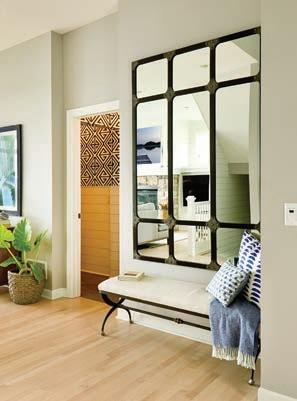



Although mirrors are most frequently used to reflect light, outdoor beauty and personal appearance, there are additional creative uses for mirrors. When incorporating mirrors into your interior design, consider one of the following novel applications:
n Mirrored tiles for a kitchen backsplash
n Mirrored insets in kitchen cabinet doors
n Mirrored accent furniture and accessories for any room
n A mirrored headboard
n Groupings of mirrors for a gallery wall
n Mirrors as substitutes for artwork


n A mirrored wall to create drama and the illusion of more space
n Mirrors behind lamps to reflect more artificial light into rooms
n Mirrors behind plants
n As a decorative touch between two windows
n Full-length mirrors mounted on the backs of bedroom doors, fronts of closet doors, or standing in frames
n Mirrors mounted in gardens
With so many styles and sizes available in-store and online, myriad options exist for introducing the magic of mirrors into our living spaces and proving true Dorothy’s fabled saying, “There’s no place like home.” ✦


At Fortress Foundation Solutions, we specialize in providing expert foundation repair, basement waterproofing, crawl space encapsulation, and concrete lifting and leveling services. With years of experience and a commitment to customer satisfaction, we are the go-to solution for homeowners looking to protect their properties from water damage, structural issues, and the harsh elements.
As springtime showers bring the promise of blooming flowers, they also bring the risk of water entering your basement. Heavy rains in April can quickly lead to flooding and water damage, which can compromise the integrity of your home’s foundation. That’s where we come in.
Our Waterguard system and Triple Safe Sump pump are essential tools to ensure your home stays dry and safe throughout the rainy season. The Waterguard system is designed to prevent water from seeping into your basement, while the Triple Safe Sump pump provides three levels of protection to efficiently pump out any water that does make its way inside.




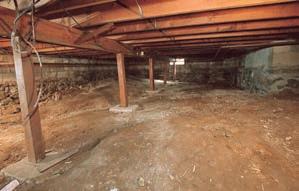

In addition to waterproofing, we offer comprehensive foundation repair services to address issues like cracks, settling, or bowing walls. For crawl spaces, our encapsulation solutions keep moisture at bay, protecting both your home and air quality. Our concrete lifting and leveling services restore stability to uneven surfaces, making your home both safer and more attractive.
Don’t wait for water damage to affect your home. With Fortress Foundation Solutions, you can trust us to safeguard your basement and foundation from the unpredictable weather. Prepare for April showers today and enjoy a dry, safe and stable home year-round.





Eight ways to boost your mood and care for your overall well-being as we close out the cold-weather season

BY SHELLEY BASINGER
In my opinion, actor Bill Murray described winter perfectly in his iconic 1993 comedy Groundhog Day — “It’s gonna be cold, it’s gonna be gray, and it’s gonna last you the rest of your life.”
I try to embrace each season as it comes, but at some point in late January/early February, it starts to feel like the chilly, overcast days will never end.
As a seasoned winter-blues fighter, one thing I’ve learned is that passing time on the couch under a heated blanket is relaxing but not necessarily invigorating. You have to be proactive and intentional to end your day with a brighter spirit.
Here, I’ve rounded up eight ideas to help you stay energized as we anxiously await the arrival of spring.

Get some fresh air.
Seasonal affective disorder (SAD) is a type of depression that occurs during the winter when daylight hours are short. The lack of sunlight can throw us off, leading to a depressed mood.
We can counteract this by getting as much sunlight as possible. You’ve also probably experienced the immediate mood-boosting effects of some crisp, albeit cold air hitting your lungs; it’s always a refreshing change from the stuffy, dry conditions in our heated homes.
Whether it’s a 30-minute walk around your office building at lunch or a long hike on the weekend, time outside during the wintertime can be a game changer for your mental health.
Look at the world from a different (point of) view.
Take the fresh-air challenge to the next level by venturing to an outdoor spot with a view, which can often give us a renewed sense of perspective. There is no shortage of peaks, cliffs and beautiful vistas to enjoy in Virginia.
If you have a full day on your hands, one popular destination is the Peaks of Otter, where you can make the trek (about 2.5 hours up and back) to the top of Sharp Top. You can find other trails for all skill levels at the Peaks of Otter and nearby on the Blue Ridge Parkway.

Another day trip suggestion is the trail at the Smith Mountain Cooperative Wildlife Management Area, where you can hike from 800 feet to 2,000 feet and take in a stunning view of the lake region. The best part about visiting this trail in the wintertime is there are no leaves to obstruct your view.
Try a hike near downtown by climbing to the top of Roanoke on the Mill Mountain Star Trail. Accessible to hikers of all levels, the Mill Mountain Star Trail offers a well-maintained path through diverse landscapes; the highlight of the trek is the majestic Roanoke Star.




3
Bring the outdoors, in.
Skip the wine aisle at the grocery store and buy yourself flowers instead! The pop of color in your kitchen or dining room is the perfect reminder that spring is around the corner.
You could also add a new plant to your indoor lineup. Staff at Townside Gardens on Franklin Road SW can recommend choices that are aesthetically pleasing and offer natural benefits.

4
Schedule a chuckle session.
Laughter really is the best medicine. According to the Mayo Clinic, laughing causes you to breathe in more oxygen-rich air, stimulates your main organs (heart, lungs and muscles), and increases the endorphins that are released by your brain. Endorphins are the “feel good” hormones produced by the pituitary gland.




Make laughing the focal point of a night out! Catch a standup comedian, a funny stage show or go to a movie. If attending a show isn’t an option, my family keeps it simple by watching “funny dog videos” (or search something similar on YouTube) as a group in our living room. You can also try a new silly board game or card game with friends and family.

Tackle a done-in-a-day home project.
I say done-in-a-day because what doesn’t lift my mood is spending weeks with an unfinished project within arm’s reach! This project could be as simple as updating your bedding


and pillows, painting a small room or old piece of furniture, or creating a new accent wall with beadboard or wallpaper. Small projects enable us to enjoy a sense of accomplishment at the end of the day and feel recharged.




6
Book a spa appointment.
When conducting an informal poll as research for this article, several of my friends said a good old-fashioned pedicure is their go-to way to beat the winter blues.
Another healing option is London’s Salt Spa in Bedford County. They offer massages and facials, but the main draw of their facility is the therapeutic salt cave. Inside this cozy, tranquil room you can prop up your feet in a zero-gravity chair and breathe in air that their website claims is 10 times purer and filled with more than 84 minerals, including lithium (a proven depression fighter) and selenium (improves sleep).
7
Try something new.
Oftentimes in the middle of winter, I just feel a little stuck. Get out of your routine with a new activity, craft or class that helps you explore something you haven’t tried before.
There are a plethora of art-focused establishments with a revolving list of art classes in Central Virginia and Roanoke.
In Moneta, people are raving about Hawaii Fluid Art, a brand-new artisan space. Their 1- to 1.5-hour classes include everything you need to create a beautiful work of fluid art, which is an abstract painting technique.
Those who enjoy spending time in the kitchen should keep tabs on cooking classes at The Flour District in Lynchburg or make it a weekend with Albemarle County’s Pippin Hill Farm & Vineyard’s Cooking School.
At minimum, open up that recipe reel you saved on Instagram and give it a try!
8
Wander around a bookstore or library.
If you’re like me, you’re always in a rush to get to the next activity, destination, birthday party or sporting event.
That’s why I get such a mood boost when I get the opportunity to go to a bookstore (alone … no children or husband allowed) with absolutely no shopping list, purpose or time limit.
One of my favorite places is Lynchburg’s Givens Books & Little Dickens, where you can also splurge on a specialty coffee drink from Corduroy Coffee & Kitchen and sip while you shop. I always enjoy perusing the staff recommendations shelf near the front of the store and the used book section located in the back.
In Roanoke, check out Too Many Books in Grandin Village or Book No Further in Downtown Roanoke, both of which truly live up to their names! You’ll find new and used books galore.
You don’t have to do this whole list to feel good. Just try one new thing. Don’t let winter become an endless Groundhog Day. Take care of yourself and make the most of this season! ✦


























BY BECKY CALVERT | Photography by James River Media
As far back as the Aztecs, chocolate has been associated with love. Considered an aphrodisiac, it has been shown to improve mood as well as have health benefits, particularly dark chocolate. It was during the Victorian era that chocolate became associated with Valentine’s Day, when British chocolate maker Cadbury launched one of their coveted “Fancy Boxes” in the shape of a heart for the holiday. These decorated boxes filled with confections were highly valued by Victorians, who ate the candy and kept the boxes, turning them into places to store mementos.
We still see those heart-shaped boxes pop up this time of year, as chocolate continues to be an essential Valentine’s gift. As with any occasion, giving a handmade gift adds an extra touch, as they are made with love. This Valentine’s Day, why not try making sweets for your loved ones? You can never go wrong with chocolate.

Hershey’s Best Brownies
(adapted from Hersheyland.com)
I first came across this recipe in a Hershey’s cookbook, and it quickly became my go-to. This creates a fudgy brownie, so let them cool before cutting into them — they are rather gooey when hot. Sometimes I’ll add chocolate chips for extra chocolate goodness, but it’s not necessary.
½ cup butter, melted
1 cup sugar
1 teaspoon vanilla
2 eggs
½ cup unsifted all-purpose flour
1/3 cup cocoa powder
¼ teaspoon baking powder
¼ teaspoon salt
Preheat the oven to 350 degrees. Blend butter, sugar and vanilla in bowl. Add eggs, and beat well with a wooden spoon. Combine flour, cocoa, baking powder and salt. Gradually blend into egg mixture. Spread in a greased 9-inch square pan. Bake for 22 minutes. The brownie will be starting to pull away from the edges of the pan. Let cool before cutting into squares.


Make these with good dark chocolate, and storebought peanut butter cups will pale in comparison. Yield: about 32
3 cups chocolate, chopped for easier melting 1 cup peanut butter ½ cup powdered sugar 1 teaspoon salt
Line a mini-muffin tin with paper liners. Melt half the chocolate in a double boiler or microwave. Using the back of a spoon or a pastry brush, paint a layer of melted chocolate on the bottom and sides of the paper liners. Coat them generously. Set aside and let cool.
Combine the peanut butter, powdered sugar and salt. Stir until well combined. Divide into small, even mounds. Set each one into your chocolate bottom. Tap down with your fingers to “nest” it into the chocolate bottom.
HOME tip: Use a plastic knife when cutting brownies for a cleaner cut!
Melt remaining chocolate. With a spoon, dollop the top of each peanut butter mound with a generous portion of chocolate. Using the back of a spoon, smooth out the tops. Place muffin tin in refrigerator, and let chill for about an hour or until set.


Chocolate Slab (adapted from BBCgoodfood.com)
This is so fun and easy to make, especially with kids. While this version calls for topping it with candy, it’s also fun with nuts and dried fruits. It works as a great gift any time of year, not just Valentine’s Day!
12 ounces milk or dark chocolate
4 ounces of white chocolate
Assorted candies
Line a baking sheet with parchment paper. Break the milk or dark chocolate into a bowl, and melt it — either in a double boiler (a mixing bowl on top of a pot of boiling water) or in a microwave — stirring every 30 seconds. Pour chocolate on parchment paper, spreading in an even layer. Prepare the white chocolate the same way — break it into smaller pieces and melt it. Dot it on top of the milk/dark chocolate, then use a toothpick, skewer, or fork to swirl it around into a pattern. Top with assorted candies. Leave at room temperature to cool. Or to hurry up the process, stick in the fridge for a half hour or so. Break into shards to serve. ✦
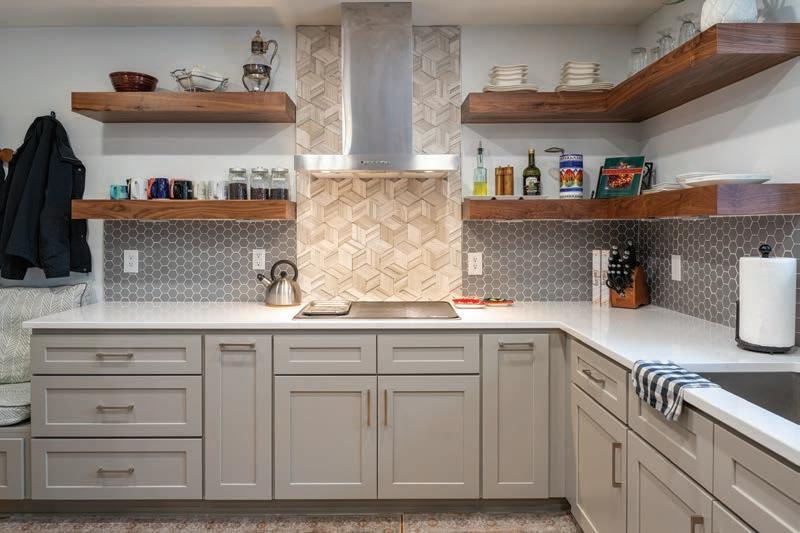



BY JERRY HALE
Having some type of home workshop is a must for most homeowners. For some, puttering with tools that can make and fix things is therapeutic. For others, the ability to manage simple and moderately-challenging home improvement and maintenance tasks is convenient and precludes the need to pay a pro whenever something needs repair. Still, others take working with their hands to the hobby level and beyond, making furniture or functional and decorative objects out of rare and beautiful wood or undertaking home renovations.

Here are a few ideas for equipping and organizing this space.
First, think about how you might use a workshop; the most useful shops are designed and equipped with a clear vision of what will be accomplished there. Think it through — for the near term and allowing for expansion as your interest and skills develop.
Next, consider the location and size of your shop. A corner of the garage or basement can be sufficient for organizing and storing common DIY tools. A sturdy workbench — either homebuilt or purchased at a home improvement center — typically has at least one lower shelf for tool boxes. Square, heavy-duty plastic “milk bottle” crates, available at home improvement stores or even as file boxes at office supply outlets, hold oodles of tools or supplies and will fit on the shelf or slide easily under it. A pegboard or mid-range cabinets above the workbench will keep tools organized within easy reach.
Kitchens, Bathrooms, Whole -House Remodels, Additions and More




A table saw, either portable or fixed, is the cornerstone of any woodworker’s shop. Working with long planks, moldings and sheets of plywood, composite, masonite or paneling will require space for infeed and outfeed support platforms. Serious woodworkers will add a joiner (for creating true edges on wood stock), planer (for smoothing wood surfaces) and router (for hollowing out, creating edges, decorative scrolling, etc.).
A drill press, band saw or chop saw (for precisely cutting trim moldings, frame corners, etc.) complement your collection. Radial arm saws, good for cross and angle cutting, are notorious for projectile incidents when ripping long boards.




Tools every workshop needs
Here are some of the tools and equipment that are handy to have for basic woodworking and miscellaneous home fix-ups:
n Saw horses
n Tape measure
n Calipers
n Straight-edge metal ruler and square; carpenter’s pencil
n Stable work table with vise
n Cordless drill/impact driver combo
n Nail gun and “pancake” compressor plus several sizes of nails
n Hand saws – cross cut, rip, coping and hack saw for metal
n Claw hammer
n Hand plane
n Level
n Mallet and assorted chisels
n Variable speed palm sander and selection of sandpaper
n Fine and course grinder
n Assorted screw drivers, both flat and Phillips-head
n Pliers (standard, needle nose), adjustable locking gripper
n Wire cutter
n Swiss-Army style pocket knife
n Jig saw
n Vibrating or oscillating multi-cutter
n Squares, clamps and level
n Wood rasp and metal files
n Quality all-in-one tool kit with selection of drill bits, sockets, box and open-end wrenches, Allen wrenches, nut drivers, etc.
n Tool bucket or tray, bag or belt (also for taking needed tools to work location)
n Tin snips
n Soldering iron
n Caulking gun
n Glue gun
n Shop vac
n Stool and perhaps rubber mat if floor is concrete
n Safety glasses, dust mask, ear plugs, leather gloves
n First aid kit



“The best lathe,” says master DIY guy Rick McKown of Moneta – a retired mechanical engineer who can build or fix about anything around a home, “belongs to a friend who’s really into woodturning. Unless that’s your passion, you don’t need your own.”
McKown also recommends creating an inventory of glues, wood and machine screws, bolts and nuts, dry-wall anchors, wood fillers, patching compounds and the like. “Minor jobs become major time consumers when you have to repeatedly stop working and run to the hardware store for what you need.”
Because of the noise and dust workshop power tools produce, the further from other living spaces you can locate them the better. A separate shop building is ideal, but a portion of the basement – walled off to contain dust and noise – is likely a more-practical option.
Having a workbench and common mini-fix tools (pliers, screw drivers, box cutter, X-acto knife, Allen wrenches, socket set, nut drivers or box wrenches, etc.) in the garage is handy, but “... putting woodworking machinery there is simply asking for fine layers of dust to blanket cars, garden tools, and whatever else resides in the garage,” McKown cautions.
Power saws and dust collection systems are noisy, so think through the impact they will have on others in the household. Also consider the electrical service you’ll need: will a woodworking machine require a 220-volt circuit? At the very least, you’ll want several outlets or a quality power strip within easy reach of your workbench top for plugging in tools, charging batteries and powering the lighting to illuminate your work area. Good overhead lighting, by the way, is key to a safe workshop environment.
Your workshop will be home to the many tools you already own, and you’ll be adding some needed for future projects. Don’t be tempted by bargain-bin brands. Instead, spend what it takes to acquire quality hand tools, power tools with brushless motors and ball bearings instead of bushings, and longer-lasting batteries. Cheap tools are rarely up to the task, won’t last and may not be safe to use. Quality tools make jobs go smoother, will last nearly a lifetime, and may well preclude a trip to the emergency room! Online research about what you intend to buy is an excellent use of your time.
Now, get to work! ✦
HOME Magazine helps your messages reach consumers ready for your products and services. In the fall of 2024, Eastlan Ratings sampled area residents ages 35+ and found HOME to “significantly outperform” the local media market in audience quality and purchasing influence.
HOMEOWNERS
AUDIENCE PREFERENCES & PLANS
NUMBER OF HOME MAGAZINE READERS PER ISSUE
PREFER LOCAL BUSINESSES
AUDIENCE INTERACTION WITH HOME MAGAZINE
DISTRIBUTION

Targeted direct mail

Mass distribution

Online
EXCLUSIVE HOME & GARDEN MAGAZINE SINCE



We don’t reach just any audience — we connect with your best customers. Let us help your business soar in 2025!


2024 was an important year for local Class A contractor GroundScapes, as it marked their 20th year in business! GroundScapes President James Edwards says that two decades of successful contracting is an important milestone, and he is very thankful for all the people who have made the company a success.
“Not only do we have amazing customers, but we also have the best employees I could dream of. I sincerely love all of the people that have made these 20 years so special!” Edwards says.
If you have driven around Roanoke or Smith Mountain Lake and seen a breathtaking oasis in someone’s backyard that would rival any five-star resort and make your jaw drop, there is a high probability that you have seen a GroundScapes project! GroundScapes is known to Roanoke for its amazing outdoor living areas and resortstyle backyards, but they are experts with much simpler landscape and hardscape installations also.
We chose GroundScapes mainly because of the integrity I sensed as I spoke with James Edwards. If you are in need of any type of work GroundScapes offers, you would be fortunate to have them do the work for you.
-Mike & Ann Harper - Moneta, VA




“With our 20th anniversary here, I want our customers to know how much they mean to us and how much we appreciate them. Without them we just wouldn’t be here, and we wouldn’t be the welloiled machine we are today!”
“Our specialty is certainly custom, resort-style backyards with outdoor pavilions, decks, patios, pools, spas, fireplaces, outdoor kitchens and so on,” Edwards says. “But it takes a good mix of projects for us to maintain an efficient work schedule for our crews, so we appreciate the small jobs equally as much as the bigger ones!” He adds that although there is a cost associated with the upscale backyard living area projects GroundScapes specializes in, most of our clients end up saving thousands of dollars per year on vacations. The reality is that they would rather just stay home after we have designed and installed a backyard project for them!
When asked about the biggest changes in the industry in the past 20 years, Edwards says, “These days there are a lot more inexperienced competitors underbidding and not understanding the complexity of these types of projects. There’s a lot going on with these elaborate residential construction projects, and there simply just aren’t many contractors in our area with the capabilities, experience or the resources to execute them the correct way — and in a way that will allow them to hold up for years to come.”


A home built for

BY KATHERINE FULGHUM KNOPF
Photography by Kathryn Feldmann
The power of gathering: “it inspires us, delightfully, to be more hopeful, more joyful, more thoughtful: in a word, more alive,” says noted author and chef Alice Waters. A place for gathering that holds a powerful draw for friends and family is exactly what Christine and Brad Broughton set out to create when they embarked upon the journey of finding land and building a forever home two years ago. With six grown children scattered all across the country, they wanted to build a retreat to welcome back their large family for holidays and vacations.








After a long search, and almost giving up the dream, the Broughtons discovered 47 acres in Bedford County at the base of The Peaks of Otter. The land contained an old, abandoned farmhouse, which was not able to be restored. The roof had fallen in, and it was unstable, but it offered inspiration and a few wonderful items such as a door and several doorknobs that they were able to incorporate into their new farmhouse design.
The Broughtons started looking at floor plans to visualize room sizes, layouts and style ideas. Having lived in Botetourt for several decades, they knew Steve Jamison of Jamison Design, a high-end builder in Daleville, would offer a good perspective on their rough concepts. When they showed him their inspiration photographs and floor plans, Steve said, “Let’s design this from scratch.” So, they did.
After building a three-bay shop building with a small, attached apartment so they could stay there on weekends during construction, Steve helped them site the house on the land. Brad and Christine regarded a few items as high priority. They wanted the view of the Peaks from both their large living room and their primary bedroom, and they wanted an easy open floor plan. “We wanted to design this place as a place for family gatherings,” Brad said. They needed space for everyone to visit in one large room. Steve helped them find the perfect spot to situate the house and to design a central great room with a wall of windows looking outward to the mountains.
Christine credits Steve with having the vision and the patience to work with them to create the floor plan. Others, such as a friend who is an architect, looked at the final plans and suggested vaulting the living room ceiling, so it caps in a peak, just like the mountains it overlooks. The wood planks they chose to line the vaulted ceiling match the wood tones in the flooring that runs through the open living spaces.


“Having this place is a dream come true,” Christine says. In just over a year, they went from vacant land to a beautiful five-bedroom home with all the special touches.
“I love to decorate,” Christine says. In this house, “I want comfort and quality, but also durability and practicality, so we can relax when the grandchildren visit.” The luxury plank flooring is indestructible. The leather chairs and comfortable couches are places to relax, without worry about spills or drops. The kitchen and dining areas blend seamlessly. With the white cabinetry built by Rutrough Cabinets in Rocky Mount, sleek black metal light fixtures carefully chosen to balance the room size and a large island painted SherwinWilliams’ Illusive Green, this living area welcomes family to gather in one space with many vignettes.


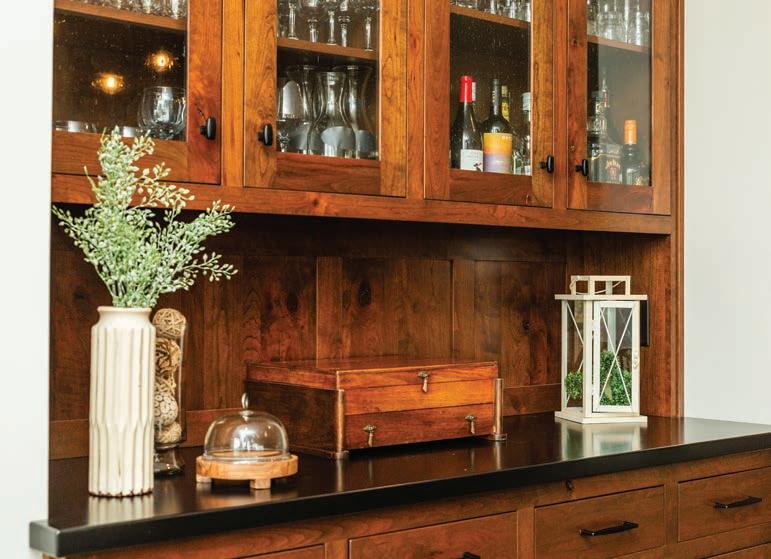


The large dining room table was the perfect find. It is handmade from reclaimed barn wood by a woodworker in Moneta. It seats 10 when it is scaled down, or with the two matching extension leaves, it comfortably holds up to 16. “It is a table where everyone can gather, which is so important to me,” Christine says. “I knew when we saw it, we were buying it,” Brad adds with a laugh.
Rutrough Cabinets designed and built a large hutch to match the table. “They were amazing,” Christine says. They also constructed the cabinets in the baths, while Steve and his team built a window bench and side shelves to create a special reading nook in one guest room. Steve’s team designed a window bench and built custom organizers in the primary closet, and his son-in-law built the wall of bookcases in Brad’s office. Steve notes, “We have carpenters on staff who can create almost anything. When we find a nook and the homeowner has a special request, we make it fit, make it function and make it look good.”
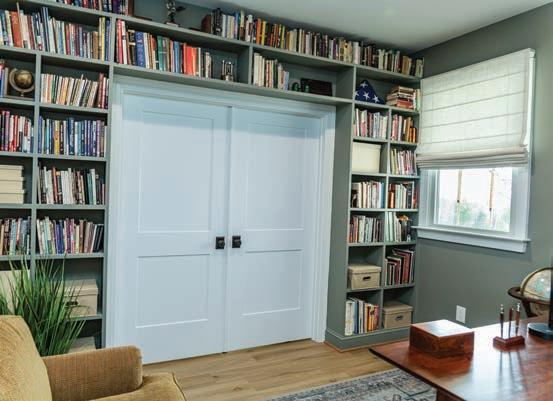

These custom details make the home feel finished and refined. Christine pitched in on a special project: the old farmhouse door that was in the original house. She painstakingly repaired and refinished the door, which Steve incorporated into the plan. It became the door to her kitchen pantry.
When choosing special touches for her home, Christine often turns to The French Farmhouse in Roanoke. “They have great accessories,” she says. Owner Ashley Lawson suggested some timeless brass accoutrements for the kitchen and dining areas. A copper tea kettle on the stove and several brass candlesticks in various heights for the table add just the right amount of sparkle. Their wreaths and home goods go well with the Broughton’s interior design style.









Outside, the white-sided farmhouse with black roof sprawls over green fields. Off the kitchen wing, a black metal fenced area holds a kitchen garden with raised beds made of cedar that was milled from trees on the property. Oregano, basil, rosemary and parsley grow in beautiful large green clumps while strawberry plants line the beds adjacent to the house.
Pea gravel paths between the beds bestow a cottage feel to this garden space. The proximity to the kitchen makes the herbs and berries ready for daily harvest when cooking meals,

or they’re easy to cut and add aroma to a floral bouquet. “The grandkids love to pick and eat the strawberries,” Christine says.
Beyond the kitchen garden, the fenced vegetable garden offers more bounty as well as the challenge of each growing season. The farm has chickens, goats and ducks that all provide a fun attraction for visitors and a bit of practical return such as eggs and milk. The land is two-thirds forest and the rest meadows. This offers plenty of space to walk, hike and explore, and just the right amount of work.





There are still plenty of plans for the future. The Broughtons’ land hosts several outbuildings. One, an old stone ruin they restored by adding a roof and a solid floor, currently serves as a garden shed. The vintage metal roof, salvaged door and cedar shutters make it modern but authentic. There is an old cabin they hope to restore, more animals to accumulate, and lots of space to grow the garden when they have the time.

Steve Jamison and the Broughtons were a good team. Steve says, “They’re really awesome people. That is what I thrive on – working with great people to deliver a quality product.” A quality product it is. Steve helped them design a home that incorporated their vision of a forever home. A place of purpose, the home beckons visitors and family. ✦

What to consider now for convenience & efficiency later
BY GINNY SMITH
Breaking ground on a new home is an exciting event that usually occurs after years of dreaming, saving, planning and decision-making. Most of us start with a pie-inthe-sky house plan and then whittle it down to something that fits in our budget. But planning before the groundbreaking ensures that we can meet our budgetary needs now and be ready for future renovations.
Alicia Smith, vice president of F&S Building Innovations, manages residential building projects. She notes, “Once you live in something a little while, you may find that it doesn’t function like it should.” With a little forethought, however, you can prepare for what’s to come and save money in the future.



The ability to flex up or down, space-wise, is very important to think about, especially if you’re building what may be a forever home. Smith recommends a higher ceiling in an unfinished basement, if the slope allows it.
“Usually, the height of a basement ceiling is 7.5-8 feet,” she says, “but that’s really too low. A 9-foot ceiling is much better. When you finish the basement in the future, you’ll have room for ceiling fans and the area will feel more like another floor and less like a basement.”
Derick Vaden of CTS&I recommends, “Do not skimp on the things that will be destructive later. Make sure your electrical and plumbing are put in place, especially in the basement.” For instance, prepare for a bathroom and kitchenette in the basement. Otherwise, you may have to break up concrete to get drains in the floor. The expense will be far less if the drains and hook-ups are already in place.
Smith suggests, “People should really consider heating and cooling their garage. If it’s climate-controlled, you can use the area as flex space when you have get-togethers. This makes a great hang-out for the kids.” Then, if necessary, you’ll be able to convert the area to living space down the road.

Time
If you are thinking about a kitchen redo, fabulous outdoor living space or getting your main suite on the main floor, now is the time to start planning. Residential construction has been extremely busy and getting started early is the perfect way to get your project in line and on the calendar for Spring.
At Building Specialists, we have the team to get the ball rolling. We have 50 years in the industry and hundreds of happy homeowners. Call us for a free consultation to discuss how together, we can get you ready for your next exciting home improvement project!



A laundry area in the primary bedroom is another good recommendation from Smith. “Especially, if you’re planning on aging in place, this area is very helpful, even if you just have room for a stacked washer and dryer,” she notes. Adding plumbing now and appliances later is always an option.
Life changes are also necessary considerations. Will you want to work from home one day? “Noise suppression for an office, additional insulation, is something to think about,” says Smith. “Working at home is so prevalent now.” When kids come along, that additional insulation is certain to be needed.
Thinking ahead is crucial. Do you want a hot tub or pool one day? A generator? If so, go ahead and put in wiring and plumbing for that now. Put in a gas line for a future fire pit. You may not choose a gas back-up for your heating system now, but put in the appropriate gas lines, so you’ll have that option in the future.
The integration of modern technology is making homes smarter, safer and more energy efficient. Be as future-proof as you can possibly be. Include plenty of power outlets and USB charging ports. If you want an electric car one day, go ahead and put in the necessary wiring.
Smart home systems with features like automated lighting, thermostats and security systems with cameras and alarms are highly desirable today. Voice-controlled systems and apps on phones enable homeowners to turn on lights or change the thermostat from remote locations.


With all the phones and devices we use today, docking stations are important clutter-busters. Smith notes, “This seems small, but can really make a big difference: have docking drawers in the kitchen and in the bathrooms. Devices and appliances can all stay plugged in, but the cords can be hidden.”
Add plenty of lighting in your home. “You might want to splurge in this area,” says Smith. “It’s the worst feeling in the world to feel like a space is too dark. Consider recessed lighting.” Think about closets, hallways, basements, any place that may need extra light.
In the kitchen, include a butler’s pantry to store blenders, mixers and air fryers out of sight. As Vaden says, “Lockers and benches can easily be added later, but the addition of plumbing and electrical comes at a price. Accessories can easily add 20 percent to a budget. So, build the kitchen you want and add the bells and whistles (like dividers, pull-out drawers and spice racks) later.”
Staircases are another important consideration. “They are expensive to put in later on,” says Vaden. “Replacing a buildergrade staircase requires a lot of destructive work. Design what you want now to avoid larger costs later.”
Will aging be a consideration in the future? “During the planning stage,” emphasizes Vaden, “design your home with every need you could possibly desire. An elevator shaft can be built in the construction phase. Maybe it’s a closet now, but an elevator in the future.”
With proper planning and forethought, your new home can fit within your budget, yet be ready for future renovations. ✦

BY SLOANE LUCAS

When the winter blues have you down or when the heat of summer is keeping you indoors, having a small indoor garden can brighten your day and give you something to tend in between spring plantings and fall harvests. Why not build a terrarium? It is easy to make, low maintenance, and it allows you to create your own little microcosm, in any theme you like.

A traditional terrarium is an enclosed glass container that creates its own mini, self-contained environment, capable of sustaining small plants with minimal or no maintenance. The circle of life takes place inside the case.
Sunlight provides warmth as well as the means for plants to photosynthesize. If the heat captured in the glass from the sunshine evaporates moisture from plants and soil, that water is returned when the evaporated water meets the colder glass, and it condenses. So, there is no water loss.
The starting soil will contain enough nutrients to support plant growth. But the soil will later become a thriving home for microorganisms, which will emit carbon dioxide. Plants take CO2 and convert it to oxygen, which supports the microorganisms. The closed loop keeps going on its own if you design it right.

Building your own terrarium is a fun and easy project, but you will need some items to get started. The key to a successful terrarium will be layering the base to provide the necessary drainage and checks and balances within the environment. The inside layers should be between a quarter to a third of the height of the overall container. Leave plenty of space for the plants. Then, you will need to choose the right plants.
Here is what you will need:
n Sealable clear glass container: This could be a large mason jar (for a mini terrarium) or a larger case like a goldfish bowl, old fish tank or any glass container that can be covered. Search at local thrift stores for creative options. Make sure the container has been thoroughly cleaned.

n Drainage layer: Begin by adding a layer of small stones or other materials such as aquarium gravel or rounded sea glass, to provide space and air for drainage.
n Charcoal: To help prevent fungi from growing on the wet stones, add a layer of activated charcoal between the stones and the next layer. You can find this at a plant nursery or pet supply store.
n Moss: To keep the dirt separated from the stones and charcoal, add a layer of moss next.
n Soil: Finally, you will add about an inch of sterile potting soil, store-bought, from the bag. Do not use outdoor soil. Transfer the soil using a clean garden trowel or a clean large spoon, for smaller containers.
n Plants: Now that you have your base, you will need to choose slow-growing plants to populate this unique environment. Some plants to choose from include:
n African violet
n Air plant
n Club moss
n Creeping fig
n Earth star bromeliad
n Hen and chicks
n Inch plant
n Lucky bamboo
n Meadow spikemoss
n Nerve plant
n Polka dot plant
n Pothos
n Prayer plant
n Dwarf ferns
n Sweet woodruff
Choose a variety of plants of different heights and leaf structures, but do not overcrowd. The plants should have space around each other while not touching the glass. Take a moment to map out where you want to plant your greenery. You can put the tallest plants in the middle and smaller plants around them or build from back to front, with taller plants in back and shorter ones in front in descending height order.

Gently lift the plants from their pots, removing any sickly or yellowed leaves, and delicately shake off as much excess dirt as possible. If the plant’s roots have wound together, gently loosen them, and then trim (aka prune) them, which will help slow down plant growth. Carefully plant them in the 1-inch layer of soil. You can use small tools like spoons and even chopsticks to help dig holes, position plants and move soil.

The terrarium is almost done – unless you want to kick it up a notch. You can add all sorts of décor items, such as seashells, mini fairy figurines or other small items to personalize the space. Next, add some water to your terrarium – but not a lot. Using a spray bottle, spritz the plants so they are damp, but not so much that water starts to pool at the bottom. Also, take a moment to wipe down the inside sides of any dirt that might obscure your view.
Once your terrarium is sealed, it should not need watering more than every 4-6 months. Only add water if the soil seems dry. Do not add fertilizer, which will spur excessive growth.
Position your terrarium in a sunny environment – but not direct sun.
Your terrarium should be a stable environment, but there are some signs that you need to adjust. If it is too dry, you can open it and add a little more water. What is more likely, though, is the environment might be too moist. If you see excessive moisture on the leaves of the plants, or if you see too much condensation or foggy glass, you need to dry it out a bit. Open the lid and let some of the water evaporate until the leaves appear dry.
Check your terrarium regularly to spot any yellow leaves or dead leaves or plants, and remove them to prevent disease. And keep the outside dusted and cleaned – so the diffused sunlight isn’t being blocked by dirt and dust.
With a little care and a lot of love, you can enjoy this microcosm of beauty and greenery for years to come. ✦


Bring a whole new look to your kitchen without having the mess and expense of ripping out your existing cabinets.
Whether you want a warm, traditional look or a modern, two-toned style to your cabinets, N-Hance will deliver a long-lasting, quality finish.














BY LAUREL FEINMAN
Random Acts of Kindness Week, February 9-15, encourages people to do small, thoughtful acts to brighten someone’s day. These unprompted, thoughtful actions — with no expectation of anything in return — can be as simple as letting someone merge in front of you in traffic, taking a latte to your child’s teacher or leaving a note of encouragement for a coworker. Research consistently shows that kindness is a two-way street: it uplifts the recipient while also improving the giver’s sense of well-being. Giving kindness creates a culture of kindness — a place we’d all love to dwell in year-round.
Kind words
Some places even have their own unique language for acts of kindness.
When Blue Bell ice cream, the iconic ice cream brand from my home state of Texas, first appeared in the freezer section of Lynchburg’s grocery stores, my friend Angie showed up on my porch with a cooler bag of pints, just because she remembered my love for it. That day, I learned the word “cerci” (pronounced sir-see), which means “a small, thoughtful gift given freely and with no expectation of repayment.”
Similarly, when I was a student at Ole Miss, I learned the word “happy” can be used as a noun to describe a small, unexpected gift or treat. As in, “Here’s a little happy for you.”
In Louisiana, the word “lagniappe” (pronounced lan-yap) captures the essence of “a little something extra.” It often refers to the unexpected bonus given as a sign of appreciation — like a shopkeeper adding an extra beignet to your order or giving you a cup of coffee “on the house.”




Random acts of kindness matter because they remind us of the power of connection. Even small, thoughtful gestures can have an outsized impact on someone’s day, creating moments of joy and reinforcing the ties that hold communities together. Here’s why these acts are so important:
n They create moments of connection. In an increasingly busy world, small acts of kindness can break down social barriers, fostering genuine human interaction and reminding us of our shared experiences.
n They spread positivity. Kindness has a ripple effect. One act of kindness can inspire others to do the same, creating a chain reaction of goodwill.
n They improve mental health. Acts of kindness have powerful physical and mental health benefits. Engaging in kind behaviors releases oxytocin, which lowers blood pressure, improves heart health, and boosts self-esteem and optimism. Kindness also stimulates serotonin production, enhancing mood, energy and well-being while reducing depression and anxiety. Overall, being kind promotes greater life satisfaction, mental health and reduced symptoms of depression, benefiting both the giver and the recipient.
n They strengthen community bonds. Random acts of kindness help foster a sense of belonging and solidarity. Whether it’s in your neighborhood or on a global scale, kindness creates stronger, more connected communities.
Kindness doesn’t have to be grand or complicated to make a difference. It’s the little things — the thoughtfulness of an unexpected gift or the warmth of a kind word — that often mean the most. Here are some ways you can incorporate random acts of kindness into your daily life:
n For strangers: Be generous with compliments and smiles; invite someone to go ahead of you in the check-out line; donate blood and/or sign up to be an organ donor; leave quarters at the laundromat or vending machine.
n For friends and family: Offer to help a loved one with a task they’ve been dreading; send a text to check in and brighten someone’s day; double tonight’s dinner recipe and share a meal with a neighbor.
n For your community: Volunteer, donate to a local cause, participate in a neighborhood cleanup; shop locally and support small businesses; donate to a Little Free Library or your local food pantry.
Consider incorporating the spirit of lagniappe — “a little something extra” — into your day-to-day life. Whether it’s offering an extra bit of time, care or attention, these small actions build upon each other to create moments of joy and connection.
Though Random Acts of Kindness Week provides a designated time to celebrate these gestures, we don’t need to wait for a special occasion to be kind. Kindness can — and should — be a daily practice. The Random Acts of Kindness Foundation offers free resources for Kindness at School, Kindness at Home and Kindness at Work initiatives. Their website (randomactsofkindness.org) includes lesson plans for teachers, printable quotes and coloring pages, calendars, games and inspirational “feel-good” stories to warm your heart. Their tagline, Make Kindness the Norm, is a sentiment everyone can support. ✦
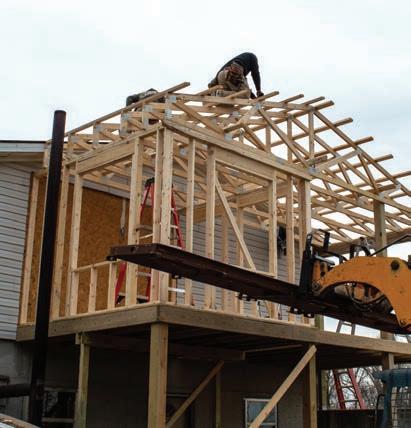

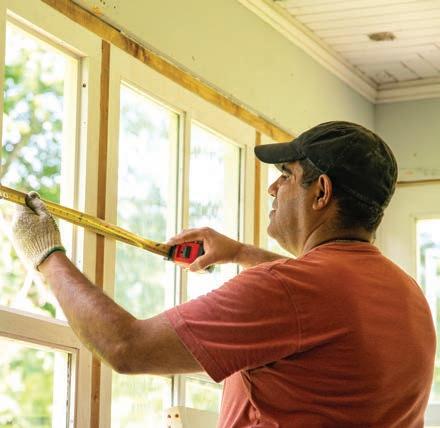

BY NICOLE VAN ESSELSTYN
You might think that homeowners’ insurance is homeowners’ insurance. Pretty much all the same and not that different now from when your grandparents got their first policy. But that’s not true. With most things related to your home, insurance changes with the times. And your choices can make an impact on your policy, too.
Duke Baldridge, president, and Mark Lowman, private client manager, from Dominion Risk Advisors in Roanoke help us understand how what we do can affect costs and coverage.



What is happening in the home insurance industry today?
This is a difficult insurance market for homeowners. Several things have contributed to this reality. The occurrence of natural disasters has increased, along with the costs of construction and the number of large claims and lawsuits. This combination has forced insurance carriers to evaluate the type of homeowners’ policies that they want to write, the types of coverage they will offer and the premiums they will charge.
Can homeowners do anything to lower their insurance costs?
A key consideration from insurance carriers is the quality of the maintenance of your home. The age and condition of your roof, plumbing, electrical and HVAC systems will have a direct impact on your premiums. Many carriers will not insure homes with a roof more than 20 or 25 years old. Insurance carriers will take photographs and may ask to tour your home. These factors will have a direct impact on your long-term insurance costs.
Other important ways to control your homeowners’ insurance premium are to have:
n deadbolt locks
n fire extinguishers
n a centrally monitored burglar and fire alarm system
n an impact-resistant roof
n an automatic back-up generator
n a water cut-off system
If homeowners maintain a good credit score, carry higher deductibles, and avoid filing small insurance claims, these actions will hold down premiums.
Finally, you will usually get better homeowners’ insurance rates when you buy your home, auto and umbrella coverage from the same insurance carrier.
What raises homeowners’ insurance costs?
Insurance companies are wary if you have hazards that pose a greater-than-average risk to your property and/or your guests and others. If your home and yard have these types of exposures, many insurance companies will not be willing to offer coverage. If it is harder to place your coverage, it is likely to be much more expensive.
For the property itself, insurance carriers may surcharge you for a wood stove and may choose not to insure you based on the proximity of trees to your home, and the age and condition of your roof and mechanical systems. Liability concerns include swimming pools, certain breeds of dogs and trampolines.




Do energy-efficient appliances, doors or windows have any impact on insurance?
What about solar panels?
There is no direct impact on your insurance cost for buying energy-efficient appliances, doors or windows. You do need to ensure that the replacement value of your home includes more expensive finishes, such as energy-efficient doors. The only additional cost associated with solar panels is that you need to add their value to your home or treat them like other structures. If you choose a non-covered contractor because their quote came in at a lower cost, know that you are absorbing that risk.

Do you need any special insurance while your house is undergoing renovations?
Absolutely. When you are renovating your home, you need to add a builders’ risk policy or an installation floater, depending upon the nature of the work. This can be added to your home policy or can be purchased by your contractor.
Do I need to tell my insurance company about renovations?
Yes. You should contact your agent to discuss the project and make sure that they add the proper coverage. In addition, you should notify your agent when you update your roofing or mechanical systems.





What kind of documentation do I need to provide my insurance company?
If you are renovating your home, you should make your agent aware. The insurance company may ask for a copy of the contract and a description of the scope of the work. You will need to notify your agent when the work is complete.
What other tips are helpful?
The purpose of a homeowners’ policy is to protect your family and your home, which is one of your largest investments. You should review your insurance policy carefully and go over additional considerations with your agent such as:
n service-line coverage (for repairing or replacing damaged utility lines that run to your home)
n back-up sewers and drains
n earthquake
n flood
n cyber insurance
The standard homeowners’ policy will have limited coverage for jewelry, furs, guns, silverware and fine arts. We suggest you get appraisals of these items and have them specifically scheduled on your policy. If you are able, we recommend that you have high deductibles and high liability limits. We recommend that you look at insuring these items as protection from a catastrophe rather than as a maintenance policy.
In addition, to protect yourself before a loss, video each room of your home, your closets and the inside of drawers. This will help you document what you own before you have a loss.
Whenever you have a major event in your life, you should discuss that with your agent. This includes a minor receiving a learner’s permit, a young adult moving out of the home, a wedding or a significant investment in your home or other assets. If you are unsure, contact your agent. They are motivated to protect you, your family and your assets.
By speaking with your insurance agent and making careful decisions, you will be able to make the most of your homeowners’ insurance – ensuring you have the coverage you need and are making the right choices for the biggest impact. ✦
BY MARGIE LIPPARD
Dopamine décor, a hot design trend that creates enriching environments, aims to make us happy. Named for dopamine, the “feel-good” neurotransmitter, the trend fuses neuroscience with interior design, intentionally transmitting love and happiness. The aesthetic advances an eclectic sensibility since what delights us

varies according to our personal histories and tastes. But psychological research finds that bright colors and sensual textures paired with bold patterns and vintage pieces fuel the natural release of dopamine and spark joy. By mining the link between our environment and our emotions, dopamine décor designers conjure captivating spaces that curate happiness.



Dopamine is a hormone and neurotransmitter produced in the brain when we experience something pleasurable. Glands release dopamine into the bloodstream, which then acts on organs and tissues that affect the body’s functions and emotions. Dopamine is also a neurotransmitter, which means it carries chemical messages across the spaces between nerve cells. It’s central to the reward pathway of the brain along with the other “happiness” hormones: serotonin, oxytocin and endorphins.


The scientific pillars of dopamine décor
Many research studies support dopamine décors’ aesthetic foundation. For example, color psychology finds that bold colors like red, yellow and orange stimulate dopamine. See our Colors of the Year article on page 18 for more on how these hues are trending.
Like its flashy fashion antecedent, “dopamine dressing,” dopamine décor boasts bright colors thought to boost your mood. When you start your dopamine décor design journey, begin with a pleasing color palette enriched by its monochromatic shades, tints and tones. Then insert pops of bold color in furniture, upholstery and throws for a refreshing uplift.
Cross-cultural studies show that people who work in lighter, brighter workspaces are more alert and joyful. Likewise, dopamine décor embraces layered and soft lighting from a variety of sources such as ambient chandeliers, cabinet task lighting, wall sconces and table lamps. These lighting sources cascade into a soothing yet well-lit atmosphere. Dimmable features enable you to customize the warm glow in each room.
Psychological research reveals that sensory-rich environments reduce anxiety and increase positive brain functions (SampedroPiquero et al). It’s therefore no surprise that sensual textures, bold patterns, and vintage pieces are touchstones of dopamine décor.
In The Aesthetics of Joy, Designer Ingrid Fetell Lee defines the dopamine décor philosophy: “As a decorating philosophy, dopamine décor emphasizes using bright colors, bold patterns and inviting textures to create a space that brings you joy. The idea is that each item of décor provides a little hit of pleasure in the brain, and that layering many of these pleasurable items together creates an environment that boosts your overall mental health.”
Dopamine décor eschews the aesthetic restraints of minimalism and celebrates maximalism’s abundance of color, texture and pattern. To this end, for a feeling of comfort and luxury, upholster your furniture with soft, sensual fabrics such as velvet and chenille. Ground all the bold elements with natural materials such as wood, stone and leather for a refreshing sensory contrast between smooth and rough. Exuberant geometric, abstract and floral patterns on fabrics and wallpaper can inspire joy without being chaotic. Display meaningful vintage and novelty items which evoke happy memories that enhance your well-being.



Most furnishings and décor generate carbon dioxide emissions since they can’t be recycled and can end up in landfills. Dopamine décor extols vintage and nostalgic pieces that are repurposed and refurbished, minimizing your home’s carbon footprint.
Thinking back to your childhood, you may recall bright colors in your bedroom, in kindergarten and amusement parks. You likely dressed in bright hues and read colorful books. Thus, it may come as no surprise that dopamine décor includes nostalgia from the past. Antique furniture, art heirlooms, treasured books and vintage mementos also instill comfort and serenity.
A hallmark of dopamine décor, plants and greenery can enhance your home’s environment and your health. Whether you want to go big with a fiddle-leaf or keep it petite with a succulent on the sill, houseplants, especially this time of year, can spark joy.
Dopamine décor not only redefines trends in interior design, but it’s making great strides in understanding how our environment affects our wellbeing. It looks to science — specifically, the neuroscience behind dopamine — to create spaces that curate happiness. Ingrid Fetell Lee cites the research done by neurobiologists Semir Zeki and Tomohiro Ishizu, who scanned subjects’ brains as they look at art. Their conclusion: When subjects look at art that they think is beautiful, they experience an increase in activity in the reward center of the brain where dopamine resides and that is active when we’re in love. Wouldn’t it be blissful if every setting in which we entered evoked love and happiness through a dopamine rush? ✦



We specialize in the professional installation of windows, doors, decks, gutters, siding and roofing to fit every need and style.
We feature Pella and Andersen replacement windows. Our window installations go the extra mile to preserve your home’s authentic details.
A great window is only as good as its installation, so why trust your installation to an uncertified contractor or worse yet, an uncertified, unlicensed and uninsured installer. Elegant Exteriors installs its windows and doors with its own employees, not subcontractors or piece workers. Elegant Exteriors by TBS, LLC is a Trex Pro as well an Andersen and Pella certified contractor which means that all of our installations come with a 2-year labor warranty.










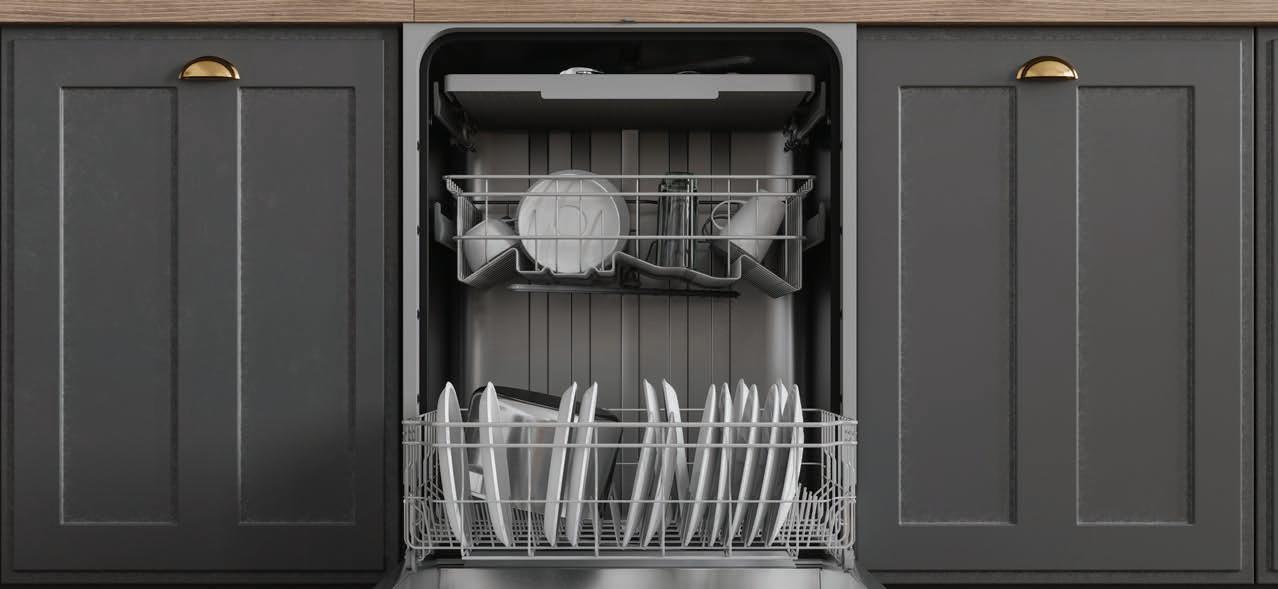
Get the most from your dishwasher
BY JERRY HALE
Most likely, many readers of HOME magazine have a dishwasher in their kitchen. It’s also a safe bet that very few of them are being used in their most effective and efficient manner. Here are 10 best practices you can use to fine-tune your own dishwasher usage and make sure you’re getting the most from this time-saving, must-have appliance.
1 RE-READ THE USER MANUAL
Try to locate where you “filed” the manual that might have come with the appliance ... or search for one (you’ll need make and model number) online. You’ll likely find several useful reminders from the machine’s designers and engineers.
2 SCRAPE, BUT DON’T RINSE, YOUR PLATES
Food scraps should be scraped into your garbage or disposal before loading dishes into the washer. This will reduce the build-up of food particles that accumulate in your dishwasher filter/trap. Most experts advise that rinsing plates is not necessary and may actually cause new washers with “dirtiness sensors” to go easy on the load. Rinsing plates,

they say, is just wasting water. However, singles or, say, retired couples who – unlike a family with children living at home –won’t typically have a full load by the end of each day may find that rinsing dishes before loading them helps minimize odors and stains.
3DON’T OVERLOAD
Cramming too many dishes into a load works against the machine’s ability to clean thoroughly. Reasonable spacing allows water to spray throughout the load as intended for most efficient cleaning. Overcrowding may even block wash arms or other moving components, hampering the machine’s performance. Waiting to wash until you have a reasonably full load, however, saves water and electricity. Strive for the happy medium.


4
CHOOSE THE CORRECT CYCLE
Most dishwashers have a choice of different cycle options depending on how dirty your dishes are; using the right one will help save electricity and water. Lightly used (e.g. breakfast bowls, toast plates, etc.) will likely do fine with a light or “economy” cycle. On the other hand, heavily soiled dishes (e.g. those that held lasagna or oily residues) will need a normal or heavy cycle. Rinsing especially dirty plates and cookware may allow them to be washed with lightly-soiled dishes on a “light” or “normal” cycle. Handwashing a few lightly-soiled items may free up space for their really dirty compadres in a “heavy” run.
5
USE A PREMIUM QUALITY DETERGENT
Skimping with off-brand detergent will not clean dishes as well and may lead to water spotting. Premium brands often come in pre-measured “pods” that prevent over-use, helping you economize to some degree. Although using a bit of extra detergent might seem like a good idea, that can cause the extra detergent to clog the machine and cause it to run less efficiently. Excess powder can also leave a residue on your glasses. Substituting a dishwashing liquid will leave your machine and perhaps kitchen floor a foamy mess. Spiking the amount of detergent you use may be helpful if you have very hard water (i.e. water with high levels of calcium and magnesium). But in areas with very hard water, installing a water softener will improve not only dishwashing, but also laundry, showers, hair washing and other general cleaning tasks.
6
USE A RINSE AID
Using a rinse aid will help ensure that dishes come out of the dishwasher sparkling clean and spot-free.


7
CLEAN THE FILTER REGULARLY
The filter or trap is where the food particles are collected. It needs to be checked and cleaned monthly to avoid buildup that can cause odors and interfere with dishwasher functioning. You’ll likely find the filter tucked into a compartment at the bottom of your machine.
8
Removing collected food crud from the door seals will prolong the seal’s life and eliminate a source of odors. A bit of dishwashing liquid and a soft brush will easily accomplish the task. The wash arms/spray bars in your machine can get blocked by food particles; manufacturers recommend removing them for a scrub and rinse every few months. Use a toothpick to unclog any clogged spray holes. Your user manual or a YouTube video will guide this easy process.
9
Amazon offers several brands of dishwasher cleaners that will remove calcium buildup. Just put a tablet into the machine, and run an empty wash/rinse cycle every several months.
10
Leaving the door a tad ajar after emptying your dishwasher will allow seals to dry completely, which helps reduce mold growth and keeps the machine smelling fresh.
Make your life easier with these dishwasher tips — and hopefully get more longevity from your appliance. ✦

For many years I dreamed of a greenhouse. My husband and I finally built that greenhouse this winter. Now I have a wonderful place to overwinter my ferns and start seedlings for the garden. This newly painted greenhouse provides me many hours of daydreaming: building raised beds behind it, arranging blooming plants on the windowsills and growing my favorite herbs in pots by the door. Dark evenings find me browsing garden books and magazines to generate new ideas.
When we embarked on this greenhouse project, it was late summer. We hired a carpenter to build it, so I planned to have it complete and ready to accept my deck plants well before the first frost. What I estimated to be an easy, twoweek project turned into an adventure that spanned months. While I am a dabbler, my husband believes in level walls and a substantial roof. There is a point to good construction. It lasts.
We finally made it to the finish line. Although the inside (my job) is only half painted, shelves are installed and some of the sturdiest plants that survived outside christen the new shelves. Now, the fun begins. I am a collector of odd gardening tools and pots, so I have an extra excuse when I veer off at junk sales and consignment shops and walk the aisles. It is time to furnish this greenhouse. Getting in my daily steps and finding the perfect accessories is an exercise I heartily embrace.
The challenges will start soon — keeping the plants alive. Growing any plant is always an experiment. There are so many factors beyond control that weigh in on success or failure. There is the weather: too much heat or cold zaps the plants. There are the bugs: good ones we need to pollinate the plants, and bad ones that eat healthy crops and build webs between the leaves and stems of windowsill beauties. And lastly, the wildlife aspect causes a gardener to lose patience. Deer, squirrels and rabbits that get to vegetables and flower heads before we do crush the spirit — no vegetables to harvest or flowers to fill vases.
There is an old saying that gardening is always about next year, and I find that is so true. The weather, the wildlife and the pests will be better. We will dig the beds deeper, plant new varieties that match our soil and the sun will shine. Life will be full of harmony and balance. Gardens are fetching when freshly planted and the pots are full and surrounded with springy moss.
Sketching the garden layout, like the drawings I made for the greenhouse, reassures — a picturesque garden without trouble or sweat. Researching the best way to get rid of spiders or aphids is not inspiring. The encounters of a half dead plant increase a gardener’s doubts — assign it to the plant hospital section, toss it in the compost bin or give it a strong talk about shoring up so it maintains windowsill club status.
Spring is full of promise just like the garden. It offers leisurely days of exploring local nurseries for plants to add to your collection. Garden shops motivate. Their vignettes of stone pots and colorful displays encourage wandering and daydreaming. Meandering their aisles, I see the potential of an effortless, charming garden. For the best day ever, head to your favorite garden shop.
— Katherine Fulghum Knopf



Purchasing a home can be intimidating for first-time buyers, but you don't have to do it alone. Our team of experts is on your side from contract to closing and beyond. We'll help you secure the financing you need, so that you can focus on making yourself at home. CHOOSE A TEAM YOU